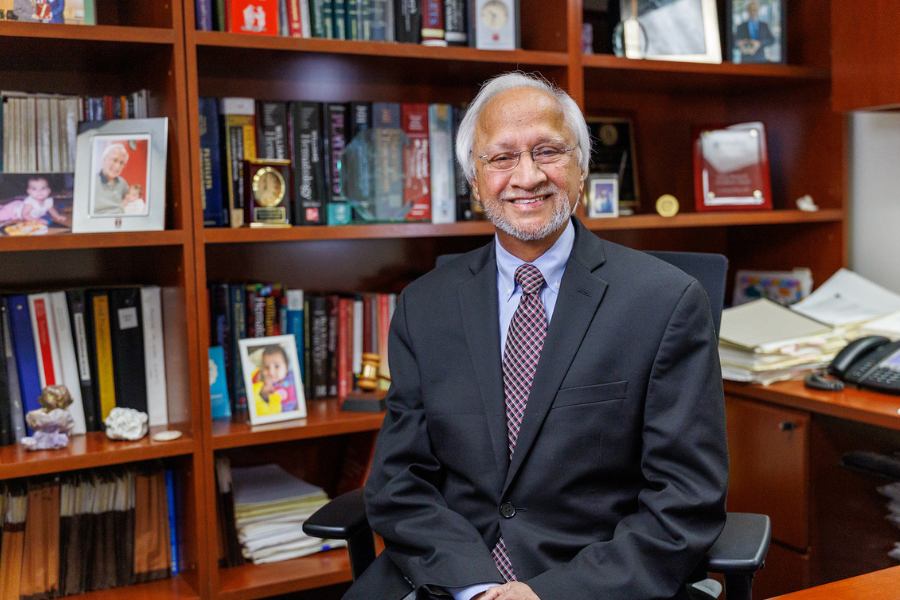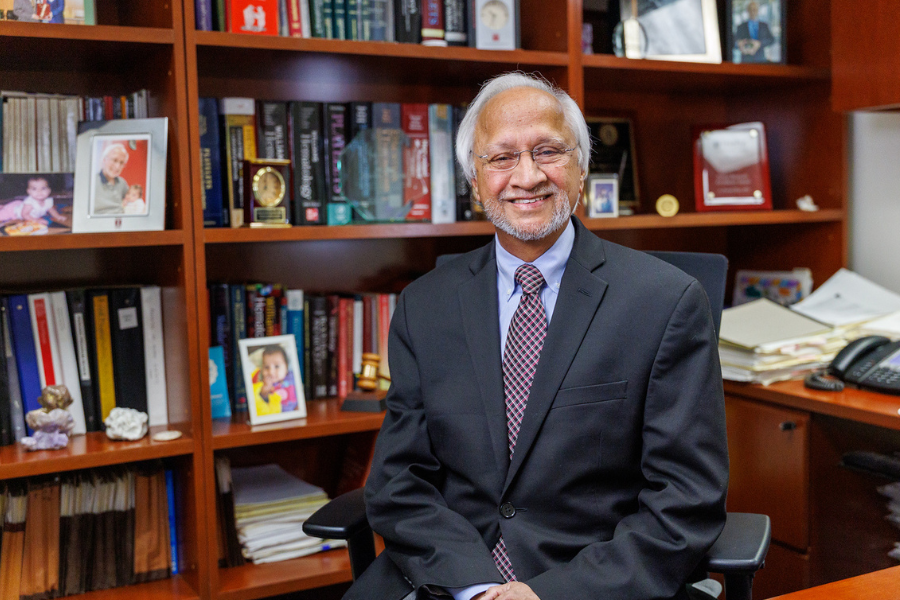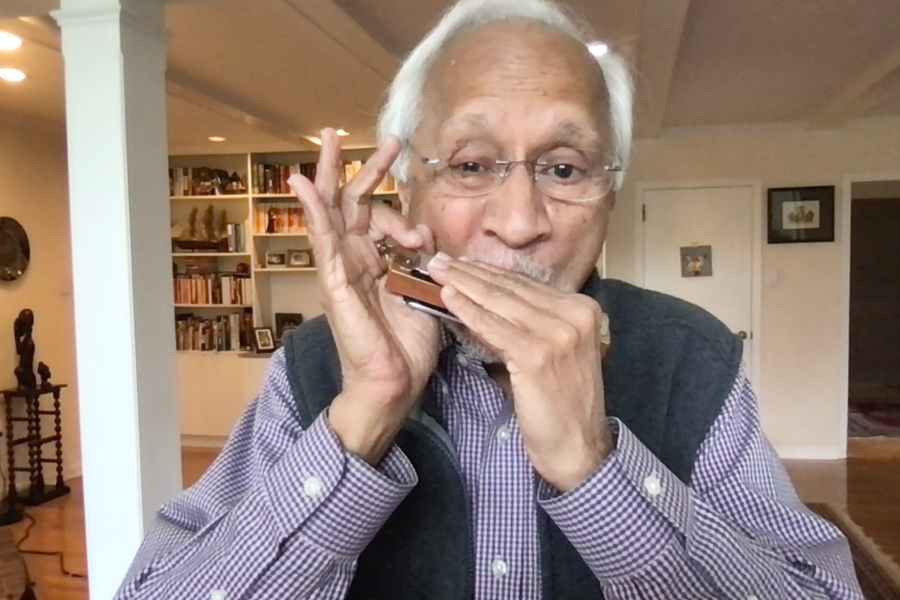A. Koneti Rao, MD knows exactly how he would sum up his 45-year career at Temple Health.
“I would use two words,” he says, without hesitation. “‘Grateful’ and ‘gratifying.’ Grateful because of the opportunities I’ve had over the years: on the clinical side, the research side, in the Thrombosis Research Center, in the Medical School, and at Temple University Hospital. Grateful to the members of my research team and for the support I’ve had all along from my family.”
“It’s also gratifying to look back and say, ‘Gosh, I’ve had the opportunity to do more than I ever thought I could,’” he continues. “On the clinical side, I’ve had the opportunity to work with patients with bleeding disorders and to feel like I’ve contributed something meaningful. On the research side, my lab has been funded by the National Institutes of Health (NIH) for over 40 years, allowing us to contribute new information in my field, especially in inherited platelet disorders.”
“On the teaching side, I’ve enjoyed working with medical students, residents, fellows, impacting their development as both physicians and scientists and serving as an editor of a major textbook. It’s gratifying to see that impact, and I’m grateful for the opportunities I’ve had.”
On the Shoulders of Giants
When Dr. Rao came to Temple in 1979, it was to pursue several of those opportunities. “I was finishing up my fellowship, and I got a call from Dr. Sol Sherry, who was then the Chairman of Temple’s Department of Medicine,” Dr. Rao says. “He said they had an opening in the Hematology/Oncology section, as well as in the Thrombosis Research Center, which he founded and directed. At that time, Temple’s Thrombosis Center was one of the largest in the country, which was why I joined the Center as an Investigator and Temple faculty member.”
Dr. Rao credits his interest in Hematology to working with Dr. Allan J. Erslev during his residency. “Dr. Erslev was a giant in the field who discovered the widely used drug erythropoietin, which causes the body to make red blood cells,” he explains. “It was a wonderful experience to be a resident on his clinical service. I got to see him as a remarkable physician and accomplished scientist, which made me interested in blood diseases.”
Collaborating with his Thrombosis Research Center colleagues in his early years at Temple strengthened and refined Dr. Rao’s interests. “I had the chance to work with Dr. Holm Holmsen, who was a legend in the field of platelets,” he says. “That got me interested in platelets, which are tiny cells floating in blood that play a role both in stopping bleeding and causing harmful clots that cause heart attacks. Most of my research interests have been in these areas, including at the lab bench in basic science as well as in clinical studies. Other studies have been on blood coagulation mechanisms and in studies on heart attacks, stroke and diabetes mellitus.”
Highlights of an Exceptional Career
Dr. Rao’s current titles—Sol Sherry Professor of Medicine, Co-Director of the Sol Sherry Thrombosis Research Center, and Professor of Cardiovascular Sciences at the Lewis Katz School of Medicine—reflect how he’s carrying on the legacy of those who have influenced him. Like them, he’s now an icon in the field—and his research and clinical interests haven’t changed.
“We wanted to understand why platelets don’t work as expected in people who have inherited abnormalities, leading to lifelong bleeding disorders,” he explains. “Some of my proudest moments have been when we’ve discovered new abnormalities, both at the genetic and functional levels. Some of these have focused on a transcription factor called RUNX1, which regulates platelets production and function.”
“As a clinician, one moment I think about is when we saw two siblings with a disorder that caused spontaneous intracranial bleeding,” Dr. Rao continues. “They had been studied elsewhere, but the cause of the bleeding hadn’t been established. We discovered that the children had an inherited deficiency of plasma coagulation Factor XIII. Once we established this defect, the children were able to receive a recombinant product—the deficient Factor XIII—every month to prevent bleeding. Their lives changed—and in fact, one of them went on to become a ski instructor!”
Dr. Rao is also proud of the recognition he and his team have received from their colleagues. He’s earned the Investigator Recognition Award from the International Society of Thrombosis and Hemostasis, Temple’s university-wide research award, and, most recently, the 2025 Dr. Joan Cox Gill Award for Outstanding Service to the Hemostasis & Thrombosis Research Society (HTRS).
“The members of HTRS are highly accomplished clinicians, basic scientists, physician scientists, and other professionals,” he says. “This award is in recognition of contributions to the field of hemostasis and thrombosis and to the society itself. Knowing some of the previous recipients, I am delighted, honored and humbled.”
Teaching Collaboration
The joy Dr. Rao takes in his work is evident, and it’s one of the reasons he’s such a favorite among medical students, residents, and fellows. “Teaching has been a big part of my career, and the message I give to students and trainees at every level is, ‘Medicine is such a wonderful field,’” he says. “You can go from seeing patients to doing research in the lab or on the clinical side to teaching and contributing to the next generation of physicians, or any combination of those activities.”
He also stresses the importance of learning from and working with those around you. “As I talk to the next generation of physician-scientists and investigators, I tell them that one of the best tools is the power of collaboration,” he says. “I’ve worked with many investigators in my own department, in the Thrombosis Research Center, in the Medical School, in the basic sciences, on the clinical side, and with members of different disciplines across the country. These collaborations provided me with immense new opportunities, and are a key element in the rapidly-moving and technology-driven area of research.”
One of Dr. Rao’s other collaborative projects is serving as one of nine editors on, and writing chapters of, the last four editions of Henry’s Clinical Diagnosis and Management by Laboratory Methods: a major textbook in clinical laboratory medicine. He has also been involved at the national level in Hematology board review courses, and served as the Associate Dean for Temple University’s MD/PhD program, allowing him to contribute to the training of the next generation of physician-scientists.
A New Tune
It’s difficult to imagine anything Dr. Rao hasn’t accomplished—but his newest interest is both surprising and delightful.
“As I get towards the end of my active professional career, I think, ‘What do I want to do that will bring new things to my life?’” he says. “That, I think, is music. I used to play a chromatic harmonica when I was in college and in medical school as part of a group, but didn’t play for many years. Now, in the last two or three years, I’ve gone back to playing it.”
“That’s probably the most exciting new thing I do,” he continues, smiling. “It’s the thing that very few people know about, but one that gives me the greatest joy as a new pursuit.”


